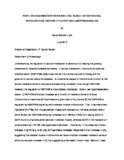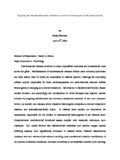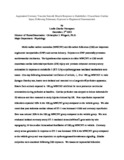Search
Now showing items 1-6 of 6
NOVEL MECHANISMS GOVERNING SKELETAL MUSCLE MITOCHONDRIAL BIOENERGETICS : OXPHOS EFFICIENCY AND cAMP/PKA SIGNALING
(East Carolina University, 2014)
Understanding the regulation of cellular metabolism is paramount to treating the growing prevalence of metabolic disease worldwide. In cellular metabolism, mitochondrial oxidative phosphorylation (OXPHOS) plays a key role ...
Targeting the mitochondrial inner membrane to improve bioenergetics in the diseased heart
(East Carolina University, 2014)
Cardiovascular diseases continue to exact unparalleled economic and humanitarian costs across the globe. Manifestations of cardiovascular diseases include acute coronary syndromes and heart failure, both of which are ...
Discovery and investigation of a novel role for mitochondrial prohibitin in mitigating acute heart failure in endotoxic shock
(East Carolina University, 2014)
Sepsis results in more than 200,000 deaths annually and is the 10th leading cause of death in the United States (US). In spite of significant advances in medical care the mortality rate for sepsis has continued to rise. ...
Augmented coronary vascular smooth muscle response to endothelin-1 exacerbates cardiac injury following pulmonary exposure to engineered nanomaterials
(East Carolina University, 2014)
Multi-walled carbon nanotubes (MWCNT) and 60-carbon fullerenes (C60) are important engineered nanoparticles (ENP) used across industry. Exposure to ENP potentially promotes cardiovascular detriments. The hypotheses that ...
The induction of antigen-specific immunological tolerance and attenuation of inflammation via cytokine antigen fusion protein therapy in a mouse model of pulmonary inflammation
(East Carolina University, 2014)
Allergic asthma is a significant medical issue, affecting more than 300 million individuals and causing approximately 250,000 deaths each year. Current asthma therapies temporarily minimize discomfort and manage symptoms, ...
IL-15 : A NOVEL REGULATOR OF LIPOLYSIS IN HUMANS?
(East Carolina University, 2014)
Interactions between and within organ systems such as skeletal muscle (SkM) and adipose tissue (AT), via immune cell signaling factors (cytokines), may regulate the development of obesity. The increased expression and ...






